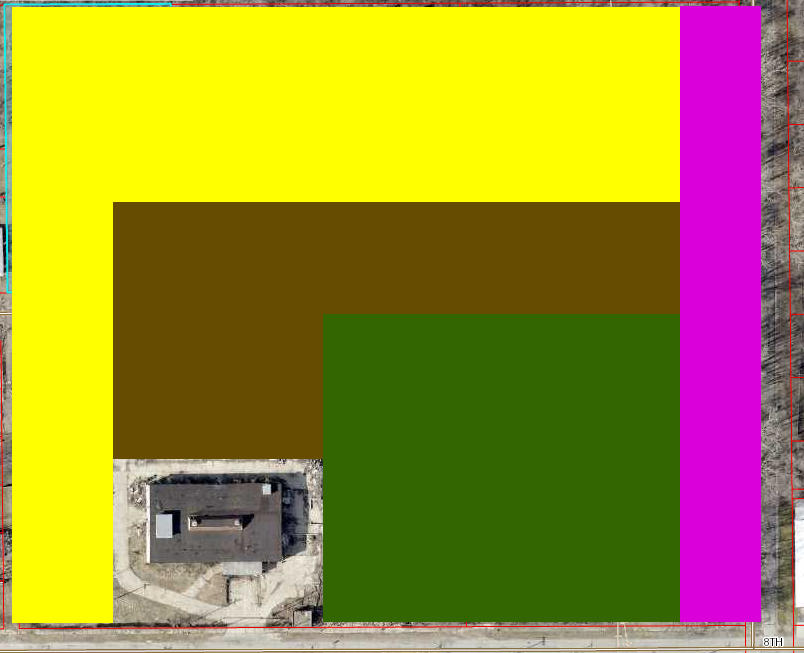The property formerly known as Franks Foundry has been donated to Farmished by the current owner, Steve Morehead. The property has a postal address of 2008 E 8th St. in Muncie, IN. Three land parcels total are involved in this plan. Steve Morehead has donated the first two and Steve Reed is in the process of donating the third to the city for this purpose. The first plot consists of parcel #114328001000, highlighted in red below and consisting of 4.5 acres.

The second plot is parcel # 1114313007000, highlighted in red below and consisting of 5.5 acres.

The third plot is parcel # 1114310006000, highlighted in red below and consisting of 1.28 acres.

In total, the parcels make up 11.28 acres and will be used by Farmished to establish the Urban Agriculture Farm.
Current Conditions

The site is 75% covered in either former foundry debris and rubble or foundry sand residual and byproduct. The remaining approximately 25% is covered in overgrown scrub brush and invasive or low value vegetation. Phase I and Phase II environmental reports conducted in 2010 indicate a variety of environmental challenges with the cleanup of the current debris. While they cite no inherent environmental dangers for an industrial site, there are some issues with the soil, water, and structures that would impair utilization for non-industrial purposes. As these studies are dated now and other efforts on the property have transpired, a new Phase I was recently completed and has found that a new Phase II study is recommended in order to understand which areas of the property need more care and attention than others. This study will be conducted along with a Hazmat assessment now that Farmished has obtained the property.





There are a few elements of debris on the site that we feel are hazardous to the community. There are several partially standing walls or parts of walls that are still elevated and could fall on a passerby fairly easy. There are many areas of broken glass, rusty nails, and other dangerous debris on the property. There are many large holes cut in the fence on the east and north sides of the site allowing for easy entry and potential danger to passersby. There are several crystal meth preparation sites along the wooded northern sections of the site that also add to the public health risk. The amount of graffiti and carried in trash on the site indicate that it is a popular traffic area for misguided youth and/or young adults, also increasing the public health risk to those individuals.
Utilization
Due to the likelihood that the site will be rehabilitated in phases, the utilization will also likely proceed in phases. Initially the site will have some zones that can be used for the compost program. While the subsequent Phase II study will confirm, we believe those areas are blocked out in solid green below.

This first phase will last quite a while most likely until additional areas of the site can be rehabilitated. As site rehabilitation allows, the compost operation will move to newly rehabilitated areas leaving the existing green zones ready for hoop house constructions to be placed on them and vegetable production to begin. Through the early phases we will heavily engage our community partners in the following ways. Dr. John Pichtel of Ball State will be conducting a series of soil sampling and phytoremediation around the property with his research team as well as using the land as a learning classroom setting for industrial site rehabilitation through plant and tree management. Candace Kindt of Delaware County SWCD will assist in the soil and water management and tree planning for the hardwood plan and orchard plan mentioned below. We will be reaching out and coordinating with Clifford Clemons of the Blaine neighborhood in conjunction with Heather Williams to conduct some baseline surveys of the residence in the community. We hope to then partner with the Blaine neighborhood to ensure we bring the highest value changes to the community first when possible. Lisa Dunaway of Ball State is also conducting an urban planning exercise this semester focusing on the Blaine neighborhood that might allow for Farmished participation. On the training front, Mike Row at WorkOne is interested in coordinating training and work effort opportunities for his contacts that could help with the site in several aspects. In addition, Tim Kean of Second Harvest is interested in helping to use this location as a food distribution location due to the location in a pretty severe food desert. This could also lead to additional assistance in transforming the property for beneficial community use.
As rehabilitation restores the landscape, we will evolve to a plan that looks something like this:

Brown continues as compost and worm farming areas. Green transitions to vegetable production. Yellow is used for various livestock activities with a portion being replanted as forest with hardwoods. The purple region is planned as an orchard, edible landscape, and recreational area for the neighborhood and Cardinal Greenway visitors. The remaining area that is not colored in will be used as utility and building zones as needed. We think this plan for the site will present a dramatic difference from the community health hazard it presents today. Not only will this site make an ideal training farm and growing facility, it will become a point of community pride for perhaps the first time in decades for the Blaine community.




